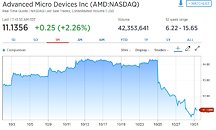
Intel Announces Strategic Investment by Silver Lake in Altera
Intel Corporation today announced that it has entered into a definitive agreement to sell 51% of its Altera business to Silver Lake, a global leader in technology investing.
The transaction, which values Altera at $8.75 billion, establishes Altera's operational independence and makes it the largest pure-play FPGA (field programmable gate array) semiconductor solutions company. Altera offers a proven and highly scalable architecture and tool chain and is focused on driving growth and FPGA innovation to meet the demands and opportunities of an AI-driven market.
Intel will own the remaining 49% of the Altera business, enabling it to participate in Altera's future success while focusing on its core business. Intel also announced that Raghib Hussain will succeed Sandra Rivera as chief executive officer of Altera, effective May 5, 2025. Hussain is a highly accomplished and visionary technology executive with strong business acumen and engineering credentials. He joins Altera from his previous role as president of Products and Technologies at Marvell. Prior to joining Marvell in 2018, Hussain served as chief operating officer of Cavium, a company he co-founded. Prior to Cavium, Hussain held engineering roles at both Cisco and Cadence and helped found VPNet, an enterprise security company.
The transaction, which values Altera at $8.75 billion, establishes Altera's operational independence and makes it the largest pure-play FPGA (field programmable gate array) semiconductor solutions company. Altera offers a proven and highly scalable architecture and tool chain and is focused on driving growth and FPGA innovation to meet the demands and opportunities of an AI-driven market.
Intel will own the remaining 49% of the Altera business, enabling it to participate in Altera's future success while focusing on its core business. Intel also announced that Raghib Hussain will succeed Sandra Rivera as chief executive officer of Altera, effective May 5, 2025. Hussain is a highly accomplished and visionary technology executive with strong business acumen and engineering credentials. He joins Altera from his previous role as president of Products and Technologies at Marvell. Prior to joining Marvell in 2018, Hussain served as chief operating officer of Cavium, a company he co-founded. Prior to Cavium, Hussain held engineering roles at both Cisco and Cadence and helped found VPNet, an enterprise security company.























